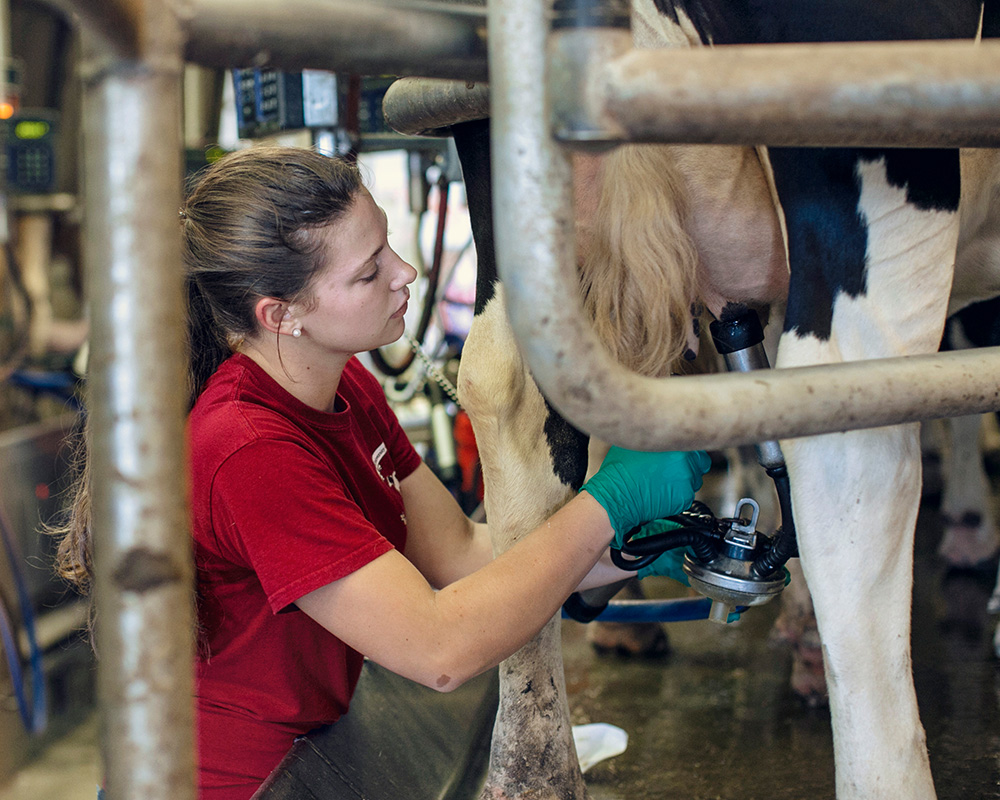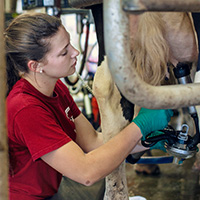By 2050, the animal and food industry will need to be able to feed a world with a projected population increase of 2.1 billion. With the help of industry and academic experts, University of Georgia researchers identified the most pressing issues for the animal and food industry to address a growing population.
A recently published journal article in Translational Animal Science identified critical industry issues using a Delphi analysis. This study was led by UGA College of Agricultural and Environmental Sciences faculty Kevan Lamm and Francis Fluharty in collaboration with doctoral candidate Nekeisha Randall.
“Our responsibility as an institution is to listen to and then to serve the needs of our stakeholders, in this case, the producers of Georgia … and around the country and the world,” said Lamm, assistant professor in the Department of Agricultural Leadership, Education and Communication (ALEC) Department.
This mixed-method research approach compiled observed issues through a series of three surveys distributed to Georgia’s animal and food industry experts. Multiple survey rounds allowed researchers to look at the list of critical issues identified by experts and group them thematically.
“Instead of trying to say, ‘We’re going to attack 40 independent issues,’ if we can collate, collapse and aggregate those issues into broader themes that are generally understood, it can help us to be a little more focused and articulate what we’re trying to accomplish,” Lamm said.
The top issues of concern fell into seven themes: industry image and relationship with the public; workforce development and pipeline; economic and environmental sustainability; animal and human health/well-being; production and distribution efficiency; government regulations and relationship with legislative leaders; and relationship with higher education/researchers.
Evaluating industry outlook
A Delphi analysis is a forecasting process framework based on the results of multiple rounds of questionnaires sent to a panel of experts. Several rounds of questionnaires are sent out to the group of experts, and the anonymous responses are aggregated and shared with the group after each round. Fluharty, the head of UGA's Department of Animal and Dairy Science (ADS), facilitated the critical component of recruiting expert panelists for the study.
“My role was really providing the names of several key people in industry across the board, from production through private industry through government entities. We wanted a good cross-section of people in order to get an accurate scope of what the issues are and to find out from various entities what the critical areas of need would be,” Fluharty said.
Fluharty identified expert panelists including policymakers, cattle and pork producers, commodity group representatives, food product industry representatives, Farm Bureau employees and others.
“Ideas that folks agree on rise to the top. We don’t know who the ideas have come from necessarily. If you’re on the panel, you’re identified as an expert. It could be a producer, it could be somebody sitting on the department of agriculture,” Lamm said. “The great ideas are retained and we use those to inform the thematic analysis.”
In the first round of the survey, panelists had the opportunity to anonymously identify in their own words the top five critical industry issues. These responses were used as the foundation for round two, in which panelists ranked the identified issues based on their importance. These rankings were analyzed and issues that scored high enough in importance were used in the final survey. Round three created a final group consensus on the issues of importance. Items that had at least 80% agreement stayed on the list and were grouped into themes.
In the final round of analysis, Randall conducted the constant comparative method. Among her other contributions to the research publication, Randall, an ALEC alumna currently pursuing her doctorate in learning, leadership and organization development, finds Delphi analysis useful in her pursuits connecting research with practice.
“My doctoral research revolves around recovering from job burnout, an interest that is very interdisciplinary and that relates to multiple segments of our population here and abroad,” Randall said. “Therefore, tools like the Delphi method offer me one more way of seeking different angles to a very multifaceted topic that researchers, practitioners and everyday people care about — which can also be said for our animal and food industry research.”
Lamm said Delphi analysis is effective in identifying the big issues because it uses two different brain functions. First, the limbic — or emotional — part of the brain allows experts to unearth big issues of interest. Then the prefrontal cortex is engaged through the logical thought process in thinking critically about those issues.
“We’ve engaged system one, that emotional brain, and system two, that logical brain. So when we do come to a consensus, folks have a lot more commitment to it and more buy-in to it,” Lamm said.
Informing change through research
Buy-in from stakeholders is crucial when implementing research-based changes. This study was part of a larger project to develop a strategic plan for ADS that is guiding curriculum and research decisions in the department. Fluharty said that is already happening through curriculum changes — such as addressing industry image and relationship with consumers — a matter related directly to animal welfare.
“We may talk about it as ‘beef quality assurance’ or ‘pork quality assurance’ but those programs are really the basis of what is evolving into a broader animal welfare discussion. If anything, this research showed that (it) is a critical component of animal production,” Fluharty said.
To contribute to workforce development in a growing field, ADS aspires to incorporate animal welfare into both production courses and departmental research in the future. They also plan to expose students to career opportunities in the field, like third-party animal welfare auditing.
ADS is particularly invested in experiential learning opportunities to encourage workforce readiness among undergraduates, of whom only about 15% come from a traditional agricultural production background.
“This research and the information we learned showed we have to have students with more hands-on experience in order to really meet the workforce needs of businesses out there,” Fluharty said.
ADS plans to address a lack of animal production experience with the creation of a student-run purebred beef cattle herd close to campus. Industry producers have been supportive of the initiative and have provided high-quality genetics for the herd. This experiential learning opportunity will give students without a production background the chance to learn about herd health, genetics, calving and more under the supervision of a small faculty group.
This faculty collaboration between ALEC and ADS has shown opportunities for interdisciplinary research and development of cross-departmental courses that could benefit students in both departments.
“I see a lot of opportunity for interactions with our students, with our graduates and with our faculty,” Fluharty said.
For more information on the Department of Animal and Dairy Science, visit ads.uga.edu. For more information on the Department of Agricultural Leadership, Education and Communication, visit alec.uga.edu.








